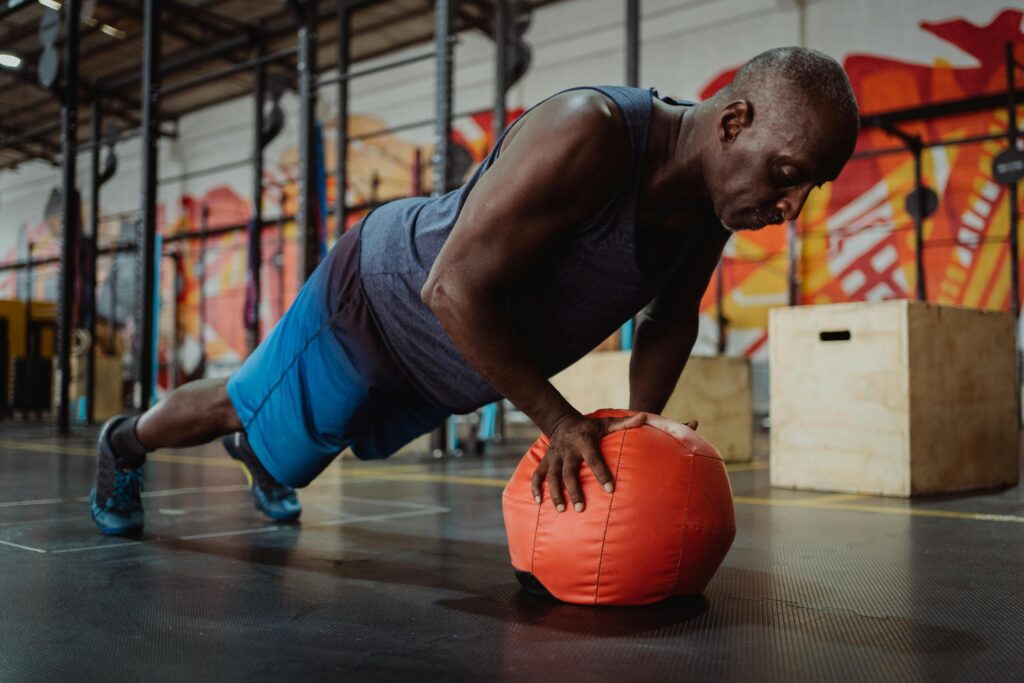
In a Nutshell
Functional fitness trains your body for real-life movements and activities.
It improves balance, strength, and coordination for everyday tasks.
Unlike traditional training, it focuses on multi-muscle, practical exercises.
Benefits include injury prevention, better quality of life, and long-term independence.
Hey there, fitness enthusiasts and couch potatoes alike! Let’s talk about the coolest kid on the exercise block: functional fitness. It’s not just another fitness fad; it’s the real deal that’ll keep you moving and grooving from a young age, well into your golden years.
What’s the Buzz About Functional Fitness?
Imagine a workout that doesn’t just make you look good in the mirror but actually helps you crush your day-to-day activities. That’s functional fitness in a nutshell. It’s all about training your body to handle real-life movements with ease. Think picking up your grandkids without throwing out your back or reaching for that top shelf without feeling like you’ve pulled every muscle in your body. In other words, functional fitness exercises are designed to mimic everyday movements and improve your ability to perform daily activities with ease.
Why Should You Care?
As we age, our bodies start to play tricks on us. Suddenly, tying your shoelaces feels like an Olympic sport. Slipping on ice may cause you to wipe out and damage a hip. But fear not! Functional fitness is here to save the day (and your dignity). It’s not about bulging biceps or six-pack abs; it’s about maintaining your independence and quality of life. Who wouldn’t want that?
Functional Fitness vs. Traditional Training: The Showdown
Now, you might be thinking, “I already hit the gym. Isn’t that enough?” Well, let’s break it down:
Traditional Training:
Focuses on isolated muscle groups
Often uses machines that control your movement
Great for building specific muscles (hello, beach body!)
Functional Fitness:
Works multiple muscle groups simultaneously
Uses your body weight and free movements
Prepares you for real-life activities6
It’s like the difference between learning to play “Chopsticks” on the piano and learning to compose a symphony. Both have their place, but one’s a bit more useful in the long run.
Real-Life Solutions with Functional Training
Let’s get practical. Here are some functional exercises that’ll make your life easier:
Squats: Master these, and you’ll never struggle to get off the toilet again. (Yes, we went there.)
Lunges: Perfect for when you need to dramatically propose… or just tie your shoe.
Deadlifts: Learn these, and you’ll be the neighborhood’s go-to person for moving furniture.
Push-ups: Because sometimes you need to push yourself up off the floor after looking for that contact lens.
Burpees: For when you drop something under the couch and need to get down and up quickly (and maybe do a little victory jump when you find it).
Here are some practical examples of functional fitness exercises that can improve your daily life:
1. Squats
Why It’s Functional: Squats are essential for activities like getting up from a chair, picking up items from the floor, and climbing stairs.
How to Do It: Stand with feet shoulder-width apart, lower your body until your thighs are parallel to the ground, then stand up.
2. Farmer’s Walk
Why It’s Functional: This exercise helps with carrying groceries or heavy objects, improving grip strength and overall stability.
How to Do It: Hold a dumbbell or kettlebell in each hand, keep your posture straight, and walk for a set distance or time.
3. Lunges
Why It’s Functional: Lunges help with balance and mobility, useful for activities like walking or hiking.
How to Do It: Step forward with one foot, lower your body until your back knee almost touches the ground, then push back up to the starting position.
4. Deadlifts
Why It’s Functional: Deadlifts are crucial for lifting heavy objects off the ground, like moving furniture or picking up a child.
How to Do It: Stand over a barbell or dumbbells, bend down and lift with your legs and back, then stand up straight.
5. Bear Crawl
Why It’s Functional: This exercise improves mobility and coordination, useful for activities that require crawling or moving on the floor.
How to Do It: Start on all fours, lift your knees off the ground, and move forward using opposing arms and legs.
6. Pull-Ups
Why It’s Functional: Pull-ups help with lifting yourself up, useful in situations where you need to pull your body weight.
How to Do It: Hang from a bar with your hands shoulder-width apart, pull yourself up until your chin clears the bar, then lower yourself back down.
7. Inchworm
Why It’s Functional: This exercise combines strength and flexibility, helping with movements that require reaching or stretching.
How to Do It: Start in a push-up position, walk your feet forward toward your hands, then walk your hands forward to return to the push-up position.
8. Mountain Climbers
Why It’s Functional: Mountain climbers improve cardiovascular fitness and coordination, useful for activities that require quick movements.
How to Do It: Start in a plank position, bring one knee toward your chest, then quickly switch to the other knee, mimicking running.
Exercises in detail
These exercises are designed to help you perform daily tasks with ease and confidence, making them perfect for anyone looking to improve their functional fitness.
Why Your Future Self Will Thank You
Functional fitness isn’t just about the here and now. It’s an investment in your future self. By improving your balance, coordination, and overall strength, you’re reducing your risk of falls and injuries. Plus, it keeps your mind sharp. Nothing says mental agility like trying to remember a complex exercise sequence!


